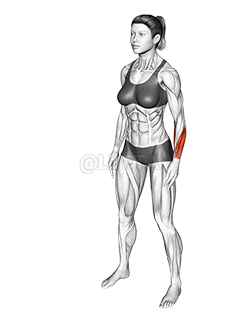
Brachioradialis
Exercise Profile
Related Exercises:
Introduction to the Brachioradialis
The Brachioradialis exercise primarily strengthens the forearm muscles, enhancing grip strength and arm stability, which are essential for various sports and daily activities. This workout is suitable for both beginners and advanced fitness enthusiasts, as it can be adjusted to fit different fitness levels. Individuals might want to perform this exercise to improve their arm strength, increase their forearm muscular definition, and support other upper body workouts by having a stronger grip and forearm stability.
Performing the: A Step-by-Step Tutorial Brachioradialis
- Rest your right elbow on your right thigh, ensuring your arm is extended and the dumbbell is hanging above the floor.
- Slowly flex your elbow, raising the dumbbell towards your shoulder, while keeping your forearm parallel to the floor.
- Hold this position for a moment, feeling the tension in your brachioradialis muscle which is located in your forearm.
- Slowly lower the dumbbell back to the starting position, repeating this motion for the desired number of repetitions before switching to your left arm.
Tips for Performing Brachioradialis
- Controlled Movement: Avoid quick, jerky movements. Instead, focus on slow, controlled movements. This will not only help prevent injury but also ensure that the brachioradialis muscle is fully engaged during the exercise.
- Correct Weight: Use a weight that is challenging but manageable. Using a weight that is too heavy can lead to poor form and potential injury. Start with a lighter weight and gradually increase as your strength improves.
- Full Range of Motion: To get the most out of the exercise, make sure to go through the full range of motion. This means fully extending and contracting the arm during each rep. Half-reps or partial movements will not effectively work the muscle and
Brachioradialis FAQs
Can beginners do the Brachioradialis?
Yes, beginners can perform exercises targeting the brachioradialis, a muscle of the forearm. However, it's important to start with light weights and focus on proper form to prevent injury. Some exercises that target the brachioradialis include hammer curls, reverse curls, and certain types of grip work. As with any exercise regimen, beginners should gradually increase the intensity of their workouts over time. It's always a good idea to consult with a fitness professional when starting a new exercise program.
What are common variations of the Brachioradialis?
- A bifid brachioradialis, where the muscle splits into two separate parts.
- A brachioradialis that is unusually long or short compared to the average.
- A brachioradialis that attaches at a different point on the radius than is typical.
- A brachioradialis that is unusually thick or thin.
- A brachioradialis that is absent, a condition which is rare but has been documented in medical literature.
What are good complementing exercises for the Brachioradialis?
- Reverse barbell curls work the brachioradialis by requiring it to stabilize the forearm and control the motion, which is a movement similar to the muscle's natural function.
- Pull-ups, especially with an underhand grip, engage the brachioradialis by forcing it to assist in pulling the body upward, thus strengthening and toning the muscle through resistance training.
Related keywords for Brachioradialis
- Brachioradialis bodyweight exercise
- Forearm strengthening exercises
- Bodyweight workouts for forearms
- Brachioradialis workout
- Bodyweight Brachioradialis training
- Strengthening Brachioradialis muscle
- Bodyweight exercises for forearm muscles
- Brachioradialis strengthening exercises
- Home workouts for forearms
- Muscle building exercises for Brachioradialis.









